DO-IT News September 2016

Volume 24, Issue 3
Below are the articles of the DO-IT News September 2016 newsletter. These articles can also be seen all on one page at the Full Newsletter option.
Director's Digressions: DO-IT Japan's Anniversary
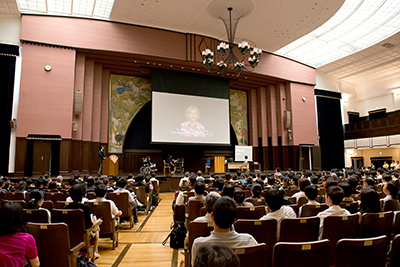
This summer, DO-IT Japan celebrated its 10th anniversary. Over 700 people attended the symposium in August 2016.
DO-IT Japan began the same year that Japan signed the United Nation’s Convention on the Rights of Persons with Disabilities. This year, ten years later, Japan enacted an anti-discrimination law, the Act on the Elimination of Disability Discrimination (AEDD). “In this decade so far, we have tried to make fair educational environments for students with disabilities along with the development of the human rights system. In the next decade ahead, based on the fair educational opportunities, DO-IT Japan plans on cultivating Scholars as leaders who can produce new values in Japanese and global society,” said Takeo Kondo, director of DO-IT Japan.
Similar to the DO-IT Scholars program in Washington State, DO-IT Japan conducts Summer Study sessions, provides mentoring, and otherwise supports students with disabilities as they pursue college and careers. To learn more about DO-IT Japan, visit their website at doit-japan.org/2016/.
DO-IT Director Sheryl Burgstahler congratulated the DO-IT Scholars in Japan by sending a video message, which can be viewed at www.youtube.com/watch?v=n60Im18300k&feature=youtu.be. In the video, she encouraged the Scholars to work hard, be flexible, and use resources. Finally, she challenged them to give back and apply what they have learned from DO-IT to help others along the way and make their society more inclusive of everyone—just like we expect of the DO-IT Scholars in the US.
Harry Potter and the Cursed Child to Release Accessible Formats
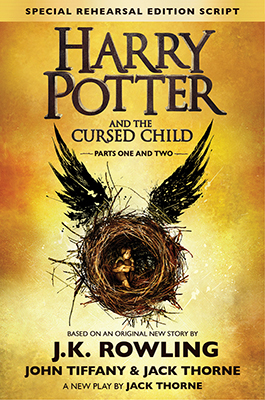
Last month hundreds of thousands of people filled bookstores around the world to get their hands on a copy of Harry Potter and the Cursed Child. Cursed Child is a new play based on the beloved characters of the original Harry Potter series and their children, but set 19 years later. Due partly by the fact that so many fans are not able to travel to the UK to see the play live, the script was published so a wider audience could experience the story. Considering that over 400 million copies of the original series have already been sold worldwide, there has been a tremendous cultural impact on children and adults alike.
With no shortage of copies available, one wouldn’t suspect an issue with getting to enjoy the story. The truth is though, that there is an entire population that has been left out of the excitement and release of Cursed Child. For people with disabilities there are barriers to accessing the media that are often afterthoughts for content creators and publishers.
In my last article I wrote about the Netflix original series, “Daredevil” (www.uw.edu/doit/disability-media-daredevil-and-accessibility-issues) and the lack of captions and audio description available despite the main character having a disability. To continue this trend, I know of no plans at the moment to release an audiobook format of Cursed Child, which may be due to it being in script form. An audiobook would likely feature voice actors, and this could be a conflict with the live version and affect ticket sales.
There has been, however, some exciting news released in July. W. F. Howes, a major publisher of audiobooks in the UK, will be publishing Cursed Child as the first ever dyslexic readers’ edition. This edition is currently for preorder and will feature large print, sans-serif font, thicker paper, and wider margins. I hope this can lead the way for future accessible versions of books, new releases in particular, to include other forms of access to people with disabilities.
As someone who identifies as a nerd and lover of many forms of media, there is something special about being a part of the excitement of something new like a book or a movie. If someone has to wait for an accessible version, they are excluded from that. Watching the Super Bowl live feels better than watching it a week, month, or even years later. Being a spectator can take many forms and is a special experience. It’s the sense of community and inclusiveness that makes our culture a more welcoming place for people with disabilities. We all deserve the right to consume media and have fun, but sometimes groups of people can slip through the cracks.
In addition to Cursed Child, all seven of the previous Harry Potter titles are available from Royal National Institute of Blind People’s (RNIB) Library in braille, large print, and talking book. The talking books (which is read word for word by someone they hired) are provided exclusively to RNIB. This likely means they are only available to those in the UK. Other formats are available for purchase in their online store.
For more information and links to the accessible editions from RNIB, visit www.rnib.org.uk/harry-potter.
For more information on the dyslexic reader’s edition, see www.wfhowes.co.uk/news/announcements/w--f--howes-to-publish-eighth-harry-potter-story-as-first-ever-dyslexic-readers--edition.
Quorum 4.0 Released
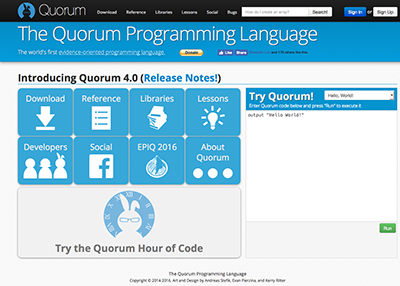
As part of the AccessCSForAll project that aims to increase the participation of students with disabilities in K-12 computing projects, Andreas Stefik continues to improve the Quorum programming language. Quorum is an evidence-based programming language that is accessible to users with a wide variety of disabilities, including individuals who are blind or low vision.
In July 2016, Quorum 4.0 was released. Two significant new features include support for 3D gaming and mobile devices. In addition, improvements were made to the development environment and existing libraries.
Learn more about Quorum at www.quorumlanguage.com/. Try your hand at programming with the Quorum Hour of Code tutorial at www.quorumlanguage.com/documents/hourofcode/part1.php.
Summer Study: What Do Phase I Scholars Do?
DO‑IT Phase I Scholars participate in a two-week, live-in Summer Study session on the UW Seattle campus. They learn about college life; explore the Internet; interact with peers, staff, and mentors; and have fun. The DO‑IT Scholars program started in 1993 as an experimental project for teens with disabilities nationwide. It is currently open to Washington State teens and is supported by the State of Washington, the Boeing Company, the Microsoft Corporation, and the National Oceanic and Atmospheric Administration.
Eyes Wide Open
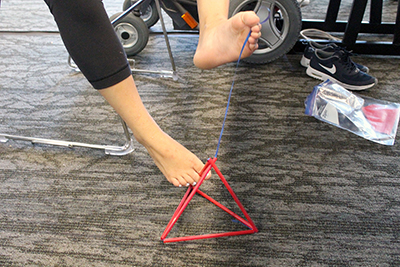
We see the world through our own narrow lens, and we each only have one life to live. We each have our own perspective on this life, and sometimes it can take having an open mind, taking on new experiences and opening our eyes to go beyond our own point of view.
Kylee-Lynn: Before DO-IT, I perceived independence to mean driving a car or living in an apartment. I have come to learn that independence actually requires many more individual steps. Before DO-IT, I never thought about it like that. I was afraid to look at life differently, but DO-IT gave me a safe place to do things I had never done before, such as test driving a scooter and putting myself in others’ shoes. These experiences have lessened the fear of going to college and changed my perspective.
Teresa: Prior to my arrival at DO-IT I saw myself as a charismatic and humble person who was easy-going, easily understood, and able to easily understand others. I thought I knew what it was like to be different. Being a DO-IT Scholar is not the easiest thing. In fact, it has significantly pushed me mentally. I had never been so included in such a diverse group. Ten days with this group of people, opened my eyes to how many different battles people are constantly fighting. DO-IT forced me to be okay with advocating for myself and for others. It forced me to be a leader and amplifies the importance of independence. I realized that all these individuals who have different abilities can do almost anything they set their mind to. DO-IT really boosted my self-esteem and reminded me that being different is okay by opening my eyes to the diversity of the world. My physical disability is only minor, and the real transformation is perspective.
Teresa and Kylee-Lynn: The biggest takeaway from attending DO-IT is the valuable perspective it created for us. We both came in afraid of judgment and hard-to-reach expectations. We both quickly realized just how irrational our fears were. The influence other Scholars had on us was a huge blessing. We both found people that had a lasting effect on our hearts. The struggles that we came in with were quickly disregarded because of the support from staff, interns, and peers. Having this experience allows us to embark into our future with our eyes wide open.
Independence Through Assistive Technology
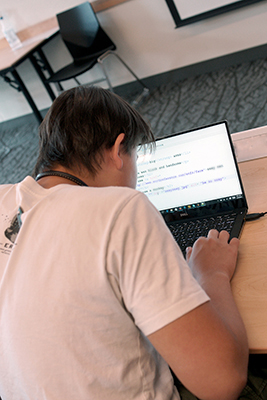
Imagine being less independent than you want to be because of a disability. People with disabilities, however, can use tools and assistive technology to make college, careers, and everyday life more accessible.
Enter Microsoft, a technology company who tries to help the larger population. Every year Microsoft runs a weeklong coding marathon, or “hack-a-thon,” geared towards people who do not usually get the chance to work together every day.
Over the past few years, Microsoft has made dramatic strides to help people with disabilities function more independently. There are many examples of assistive technology from Microsoft. One of which is Seeing AI. This program is meant to help the blind by allowing them to comprehend what is around them. When they walk past a monument or important landmark, an earpiece speaks to the blind individual about the landmark.
A person with ALS (amyotrophic lateral sclerosis) is able to regain independence, thanks to a wheelchair that is equipped with a computer controlled by one’s eyes. For example, if one looks left, then the chair will move left, without the use of a joystick, thus increasing independence of someone who may be unable to use a joystick.
Another assistive technology item is a program called OneNote, which has built in accessibility features. One main feature of this program is that it will read text to you and break large words into separate syllables. This helps people with dyslexia, because the smaller the parts, the easier it is for a text to be understood, therefore helping to increase reading speed and become more efficient. When given access to the right technology, people with disabilities become more self-sufficient.
Exploring a Makerspace
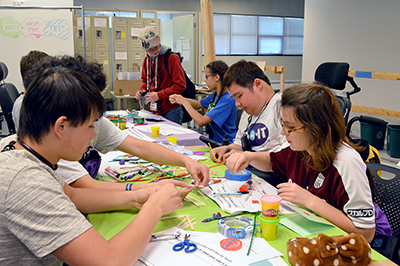
During the first Wednesday of Summer Study, the Phase I DO-IT Scholars went to the CoMotion Makerspace. Assistant professor Kat Steele introduced us to the workspace, which included 3-D printers, sewing machines, and laser cutters. We saw many students working with this equipment as well as other students designing objects with computers.
We went through the design process to learn how to build a wallet. The wallets were just prototypes, because we only had craft supplies, like pipe cleaners, duct tape, and colored paper to build the wallet. However, after building the wallet, we found its flaws and made it better, then we presented it to the group.
The Importance of Self-Advocacy
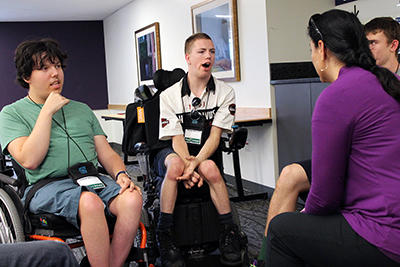
Z: Maya Angelou once said, “I learned a long time ago the wisest thing I can do is be on my own side, be an advocate for myself and others like me.” Self-advocacy is such an important skill to have, especially in college. During my high school freshman year, I wasn’t as prepared as I had thought. I had difficulties speaking up for myself, because I felt personally embarrassed being dependent on other people. It was difficult to ask people for what I needed. Being at the DO-IT program changed my mindset. I felt more comfortable advocating for myself because I was not alone. It became clear that I needed to stop depending on my one-on-one aid at school and instead advocate for me. I now know that I have rights that I shouldn’t be ashamed about. It has taken me a lot of time and practice to become a skilled advocate for myself.
Jon: Self-advocacy is used in everyday life, no matter if the person is disabled or not. Self-advocacy allows people to be more independent with their lives. During my time with DO-IT, I’ve seen more people with disabilities do almost anything. I even use self-advocacy in my life. Self-advocacy leads to independence.
Benefits of Diversity
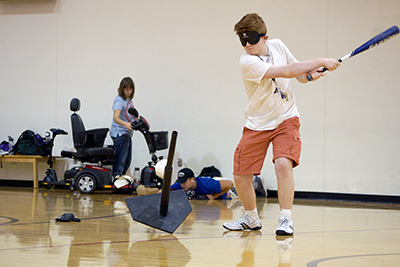
The DO-IT program has a very diverse group of people with a variety of disabilities. DO‑IT teaches a lot about accessibility and offers solutions.
We learned what it was like to have different disabilities. Through the Accessible Sports Expo, we experienced playing beeping baseball. While wearing a blindfold we hit a ball off a tee. In real beeping baseball, blind players pitch the ball and hit it, using only the sound of the ball. It was challenging relying on our ears. We also played other accessible sports, like wheelchair basketball and seated volleyball.
Even though our group is very diverse, many of us realized we face similar challenges. Some of us have found solutions to these challenges that others have not, so we learned from each other. Seeing examples of others’ solutions and learning about more assistive technology allowed us to realize we could overcome our problems.
Before the DO-IT program, we always thought “I’m a minority, so people shouldn’t have to bother helping me.” DO-IT showed us we should do all we can to make sure life is accessible so we can be successful. It was encouraging to meet other people with disabilities who share similar passions. Everyone is unique in their own way. Many people with disabilities would say their disability made them who they are and wouldn’t change it. DO-IT has made us aware of this perspective.
Why We Need Accessible Sports
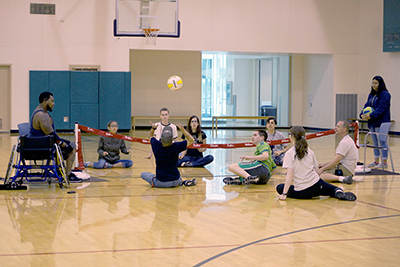
Accessible sports should be available in every school because they support unity and inclusivity for all members of the community. Accessible sports encourage people to be independent, rely on themselves and acknowledge what they bring to the table. They challenge people to improve both physically and mentally to persevere and overcome challenges. It is important for people to be able to adapt to be successful in life.
There are many kinds of sports for people with disabilities, such as wheelchair basketball, seated volleyball, and beeping baseball (a form of baseball for the blind). Accessible sports can be for anyone, such as people who are injured but still want to stay fit. When I played basketball, I understood the importance of accessible sports and had lots of fun! This just shows that no matter what disability you have, you can still play sports.
Visiting Microsoft
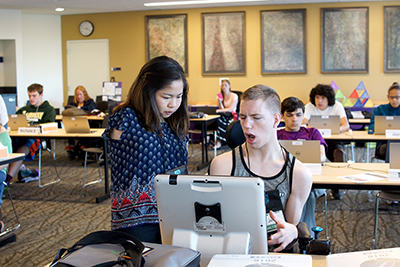
As we walked into the Microsoft building, we couldn’t help but feel a little awestruck. The buildings were big, shiny, and full of perks like a fridge full of sodas. “What an amazing place!” we thought.
We were greeted by two very enthusiastic Microsoft employees, both part of Microsoft’s accessibility department. The activity they had us do was to design a product to help people with a specific disability. Each group designed one for a different disability. The greatest creation was a unicorn-centaur product for people who lack a lower half.
We also had an amazing panel full of people who are associated with Microsoft’s disability department, which we all found very motivational. We then had a showcase of the three new innovations created to help people with disabilities. First, the Eye Gaze wheelchair, an app that helps mostly paralyzed people use their power wheelchairs. Second, a OneNote add-on that helps people read more easily. Lastly, an app that takes pictures and then tells someone what it is. Not only were the products amazing, they showed how people can help others. Many of the people behind these products did not have a disability but still they created these innovative, if not possibly essential, products. We truly were inspired. Microsoft was an amazing experience that we would preach to the entire world if we had soapboxes.
Food Critique
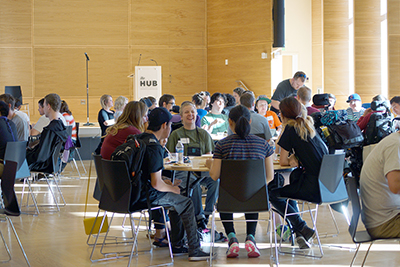
The food at Lander Hall (Local Point) may be mediocre, but it is still better than most of the food items found in your high school cafeteria. This report of the food at Lander Hall’s cafeteria covers three topics: the taste of food, dietary freedom, and the services offered.
The taste of the food at Local Point is average. It is better than most of the food at high schools and several other restaurants. Although there are different options, the taste of the food is usually the same, which is good. I wish that there were more options for breakfast, lunch, and dinner. I also wish there was more seasoning in the food. Overall, the food is good, but needs more flavor.
The dietary freedom offered at Local Point was sometimes a challenge. There are no labels on any of the items. It is crucial for people with dietary restrictions to have a clean environment where their food is prepared and labeled. The staff was quite friendly, but didn’t know a lot about allergies. This is a huge problem as one mistake could end with disastrous consequences. The staff should be well versed in all allergies to answer any questions people may have about the food that is served. Just like there is a selection of foods for vegetarians, there should be more options for people with dietary restrictions.
Lander Hall might not have the best food or dietary options, but their service was good. Whenever I walked into Lander Hall and paid for my meal, the person working the station always slid my card with a smile and asked me how I was. Also, the workers are quick to refill anything that is out and are happy to help when asked.
Overall the food and the dietary options were not the best, but what do you expect? This is all you can eat for under twenty dollars in a college dining hall. Maybe we are judging Local Point too hard, but they are just our honest opinions.
Summer Study: What Do Phase II Scholars Do?
Phase II Scholars return to the UW Seattle campus for their second Summer Study. They meet the Phase I Scholars, learn about college life and career preparation, and participate in a one-week workshop with postsecondary instructors.
Neurobiology Workshop
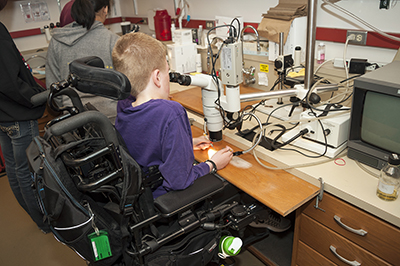
In the Phase II Neurobiology lab, the Scholars focused on how drugs affected a mouse heart and the reaction cockroach leg spines had to different forms of stimulation. The Scholars involved in this lab were Jonah, Brookelyn, Aspen, Grady, and Chana. They gave embryonic mouse hearts caffeine and Sudafed. Both of these substances were meant to increase heart rate. The goal was to see which substance excited the heart more. The Scholars also bent the cockroach leg spines in different directions and even played music in an effort to see how the musical vibrations would affect the nerve reactions.
The Scholars learned a great deal in a week. Katelyn said she “learned about how electricity flows in the neurons.” Jonah learned that “each neuron has a different amplitude, which is the height of the wave that represented the reaction of the nerves.” Chana thought that she “learned a lot about axons and how they work.” The Scholars enjoyed the lab. According to Jonah, “[They] had great teachers.” The names of these teachers were Marti, Lauren, Comron, Kelly, Josh, Chris, and Curtis. The interns involved assisted by asking questions and moving the Scholars’ thoughts along.
Robotics Workshop
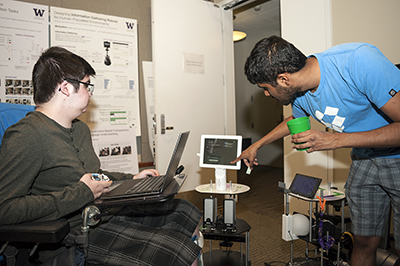
Greetings DO-IT Scholars! Welcome to Human Centered Robotics at the University of Washington. In this workshop, six Phase II Scholars learned how to use Python to program a robot to perform specific tasks.
Katie’s robot was named Khan and was programmed to assist with math tutoring. Max’s robot, Loerer, was programmed to teach languages. Laszlo’s robot, Ultravax, acted as a nurse to administer medication, and Andrew’s robot, called F.R.E.D. (French Robot Experimenting Device), was programmed to clean. Eli’s robot, Sport, provided information about sports, and Hailey’s robot, Walker, was programmed to walk a dog.
The Scholars started out by making a list of all the things they would like to do. Next, they talked about the different things each robot could be modified to do. Then they began programming the robots to do the tasks assigned. There were many changes they had to make to their program so that the robot would run.
Our Phase II Scholars learned how to teach new tricks to old robots. The sample robots were called TurtleBots, moving devices that are attached to advanced technologies like iPads and radios. They are connected to a wireless network called “CSE-Local.” Thanks to this network, the Scholars were able to program the robots through their computers. However, these tasks were difficult because computer code is usually complex.
The part that we (the Interns) liked best was brainstorming before projects. The Phase II Scholars used creative skills and functions to improve robots’ roles. Their coding was not always perfect — sometimes the code made the robots go in the wrong direction.
The Scholars learned four important steps in Human Centered Robotics: First, create ideas in coding and designing. Second, make the code in Python. Third, test the robots multiple times. Finally, let the robots perform the perfect code. Everyone, including the Interns, learned a lot from this experience.
Interning with the CNT
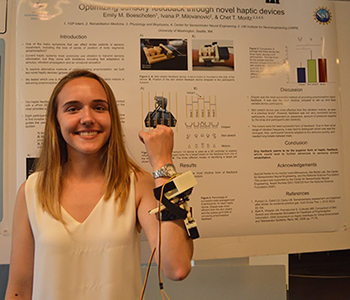
This summer, I was a member of the Center for Neurotechnology (CNT) Young Scholars Program (YSP). The program offers research experience in neural engineering as well as education in scientific skills. Topics such as neural ethics and scientific communication are also covered. I was lucky enough to be one of nine high school students selected to participate in this program. I worked in Dr. Chet Moritz’s lab at the University of Washington Medical Center along with two other high school students and two undergraduate students.
Every Tuesday morning, all of the summer interns had a weekly communication class lead by Dr. Lise Johnson. The classes focused on the skills needed to be successful in a scientific field. I found the classes to be very valuable because even though in my high school science classes we would write plenty of lab reports, I was never shown how those skills would translate into a real-world application. All of the work in this class was geared towards preparing for the research talk I would have to present at the end of the program.
We also attended study sessions led by our coordinator, Nona Clifton, where all of the high school students could meet, talk about what we learned, and clear up any questions that we had for class that morning. I was thankful for the support I was given in the study session, because a number of my classmates and fellows interns were students from prestigious schools, such as MIT. Working with Nona and my fellow YSP’s helped me keep up with the rigor of the classes and my research work within in the lab.
On Thursday mornings, we attended seminars on a variety of topics in the field of neural engineering such as industry, neuroethics, human and animal research, and impostor syndrome. Most of the topics I knew a little bit about from school, but it was extremely interesting to learn from experts in the neural engineering field. On top of these seminars, the CNT held a number of round table discussions, the highlight of which was the end-user round table. I was able to meet users of neural technology and learn how technology impacted their lives. From these discussions I could see how important the field of research is, as I was exposed to how much potential neural engineering holds in improving the lives of people with disabilities.
Prior to this summer I had minimal experience with neural engineering and engineering in general, which caused me to have a very steep learning curve. Luckily, my mentor, Ivana, was very supportive and urged me to learn AutoCAD. After watching YouTube tutorials for a week, I learned how to use AutoCAD and made two products that I am now very proud of. Working with Ivana showed me how beneficial it can be to work as a team. Both of us had different skills sets, but when we worked together we were able to accomplish more than we expected in less than nine weeks. In the short time that we had together, we were able to make two devices with AutoCAD, test what we made on nine people, and get significant data. I am very happy to have had such an amazing experience at the CNT this summer and I look forward to using all that I have learned in the future.
Visiting DO-IT
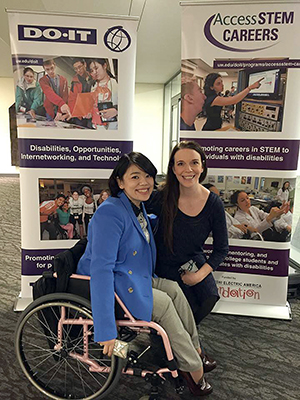
About a year ago, I attended a seminar in Tokyo and heard about DO-IT Japan and the original DO-IT Center in the United States. DO-IT, as a project that provides various opportunities for students with disabilities and promotes independence, education, and technology use, was a great place for me to visit to further my research on the topic of disability.
I first interviewed Sheryl, DO-IT founder, who was originally interested in how assistive technology could support people with disabilities to expand their abilities in education, workplace, and daily life. She wanted to reduce the gap between people with and without disabilities by utilizing her knowledge, experience as a teacher, and IT. In her work as a K-12 teacher and later at the university level, Sheryl saw the differences between the levels of education and support given—from IEP and 504 plans where students were given all of their accommodations to a college-level environment where students had to advocate for themselves.
Sheryl was often told “Students with disabilities are not prepared enough to come and study in college.” This usually has less to do with their actual academic ability than their advocacy skills, inadequate accommodations, and inaccessible environments. In seeing this gap in these issues, Sheryl started DO‑IT to support students with disabilities to transition smoothly from high school to postsecondary education and careers.
The DO-IT Scholars program allows high school students with disabilities to get a real college experience on campus for two years. The students managing their meal card budgets, practice communicating with faculty, learn about accessible technology, and gain a plethora of other skills necessary for postsecondary education. “What DO‑IT does is facilitating and trying to create an environment where these positive things happen. Leadership skills don’t just develop suddenly. Through these various experiences, people learn how to advocate and feel confident. I want to raise future leaders from DO-IT,” Sheryl said.
One of my favorite activities during the DO-IT Scholars program was a dance party. Although this may not be a crucial skill for attending college, DO-IT wants to provide more opportunities to students who may have avoided dances at their own schools. DO-IT understands that the opportunity to develop these social skills and experiences is also very important to growing up and furthering one’s education and career.
While in Seattle, I also attended a DO-IT pizza party, where DO-IT participants get together, catch up, and network about their schools and careers. DO-IT also invited parents to come to discuss and share their worries and gain information on how to best help their children. Many of the participants and parents have helped the students get into career fields or further explore their interests.
“We want to give college-bound students with disabilities the resources and skills they need to succeed at the college and career of their choice,” Sheryl said. This has inspired me even more to fight for people with disabilities. No matter what kind of disability, each person has abilities and can develop those abilities. However, it really depends on the community—if people with disabilities have opportunities to challenge themselves, they can grow.
All the students and parents I have met at DO-IT were very happy because they can see a bright future. I would love to create a society where many people with disabilities can live actively and utilize their ability for what they love, like students who joined the DO-IT Scholars program.
To read Mizuki’s article in full, visit her blog at moonrider7.com/en/.
Universal Design in Higher Education: Promising Practices Call For Articles
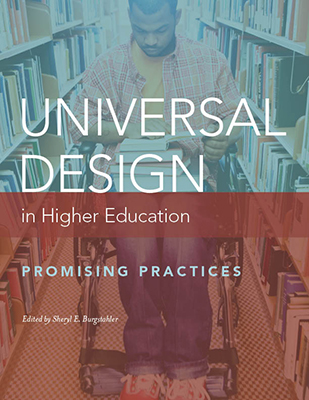
In DO-IT’s online publication, Universal Design in Higher Education: Promising Practices, practitioners share promising practices related to the application of universal design in postsecondary education settings. This collection of promising practices complements the more general content in the printed book, Universal Design in Higher Education: From Principles to Practice, which recently published a second edition under Harvard Education Press (hepg.org/hep-home/books/universal-design-in-higher-education).
This complementary publication is available freely online at www.washington.edu/doit/resources/books/universal-design-higher-education-promising-practices. It can be freely copied and distributed as a book or in part for noncommercial, educational purposes. The collection will continue to grow as more articles are submitted.
Articles may be submitted at any time to udhecop@uw.edu. Submitted articles should include specific ways practitioners and researchers have applied universal design in postsecondary settings along with evidence of success. They are peer-reviewed by members of the Universal Design in Higher Education Community of Practice (udhecop@uw.edu), and if accepted, edited by DO‑IT. Articles selected for the online resource are freely available on our website. Authors must agree to these conditions while retaining copyrights to their individual contributions. For author guidelines, consult the preface of the book at www.uw.edu/doit/universal-design-higher-education-promising-practices.
About DO-IT
DO-IT (Disabilities, Opportunities, Internetworking, and Technology) serves to increase the successful participation of individuals with disabilities in challenging academic programs and careers, such as those in science, engineering, mathematics, and technology. Primary funding for DO-IT is provided by the National Science Foundation, the State of Washington, and the U.S. Department of Education.
For further information, to be placed on the DO-IT mailing list, request this newsletter or other materials in an alternate format, or make comments or suggestions about DO-IT publications or web pages, contact us at
DO-IT
University of Washington
Box 354842
Seattle, WA 98195-4842
doit@uw.edu
www.uw.edu/doit/
206-685-DOIT (3648) (voice/TTY)
888-972-DOIT (3648) (toll free voice/TTY)
509-328-9331 (voice/TTY) Spokane
206-221-4171 (fax)
Founder and Director: Sheryl Burgstahler, Ph.D.